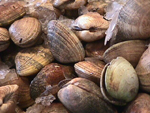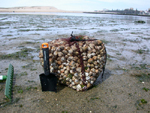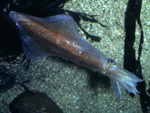| |
Molluscs
Molluscs are invertebrates that present an unsegmented soft body - covered by a layer of viscous mucus - and a branchial respiration. The body can be divided into three different parts: head, mantle and foot. Most of them have one or two calcareous shells that protect their body and get larger as the animal grows.
While some molluscs present a well-developed head, in others such as oyster and cockle is not noticeable. The mantle is a sac-like structure surrounding the animal's visceral organs; moreover, in some molluscs the mantle also secretes one or two shells that constitute the external skeleton. The foot is a large, muscular structure, which can be shaped as a flat blade (limpet, whelk, etc.), a thin blade (oyster, cockle, etc.) or, also, it can be divided into tentacles with suction cups (squid, cuttlefish, etc.).
According to the relative position and morphology of the three parts, it is possible to distinguish different groups of molluscs, namely, bivalves, gastropods (univalves) and cephalopods.
Bivalve molluscs – are animals in which the body is enclosed within a shell composed of two valves - that may be equal or different -hinged together by a muscular structure termed ligament. The typical bivalve foot is shaped as a tongue and is primarily used for motion, operating as a burrowing or attaching organ. Head is indistinguishable from the body, therefore bivalves being called acephalous. Inside the branchial cavity, there are one pair of branchiae consisting of plate-like flaps that communicate to the exterior by two siphons, through which water circulates.
|
|
| |
Univalve molluscs – are animals with a well-developed head that includes fleshy tentacles, which have vision organs but no suction cups. Most of them have a single shell or valve. Furthermore, univalves have a fleshy ventral foot that is used for locomotion. Breathe through gills. Examples are the whelk, the periwinkle and the limpet.
Cephalopods – are the most morphologically and behaviourally complex class in phylum Mollusca. They are characterized by a well-differentiated head, which is connected to a ring of tentacles surrounding the mouth. Presently, there are two great groups: the nautiloids, containing only the genus Nautilus and the coleoids that include all other cephalopods. Cuttlefish and squid are commonly called decapods since they have eight arms and two tentacles.
|
|
| |
Among all actual cephalopods, only those belonging to the genus Nautilus have a real external shell. Cuttlefish have a calcified and flat inner shell (cuttlebone). Squids possess an inner chitinous structure, called gladius. In other groups, namely the family Sepiolidae and the orders Vampyromorpha and Octopoda, the inner shell is reduced to a little rod or absent.
The cephalopod's body has a muscular mantle surrounding branchiae and all organs related to the digestive, circulatory, reproductive and excretion systems. The empty space inside the mantle is termed palleal cavity. |
|



